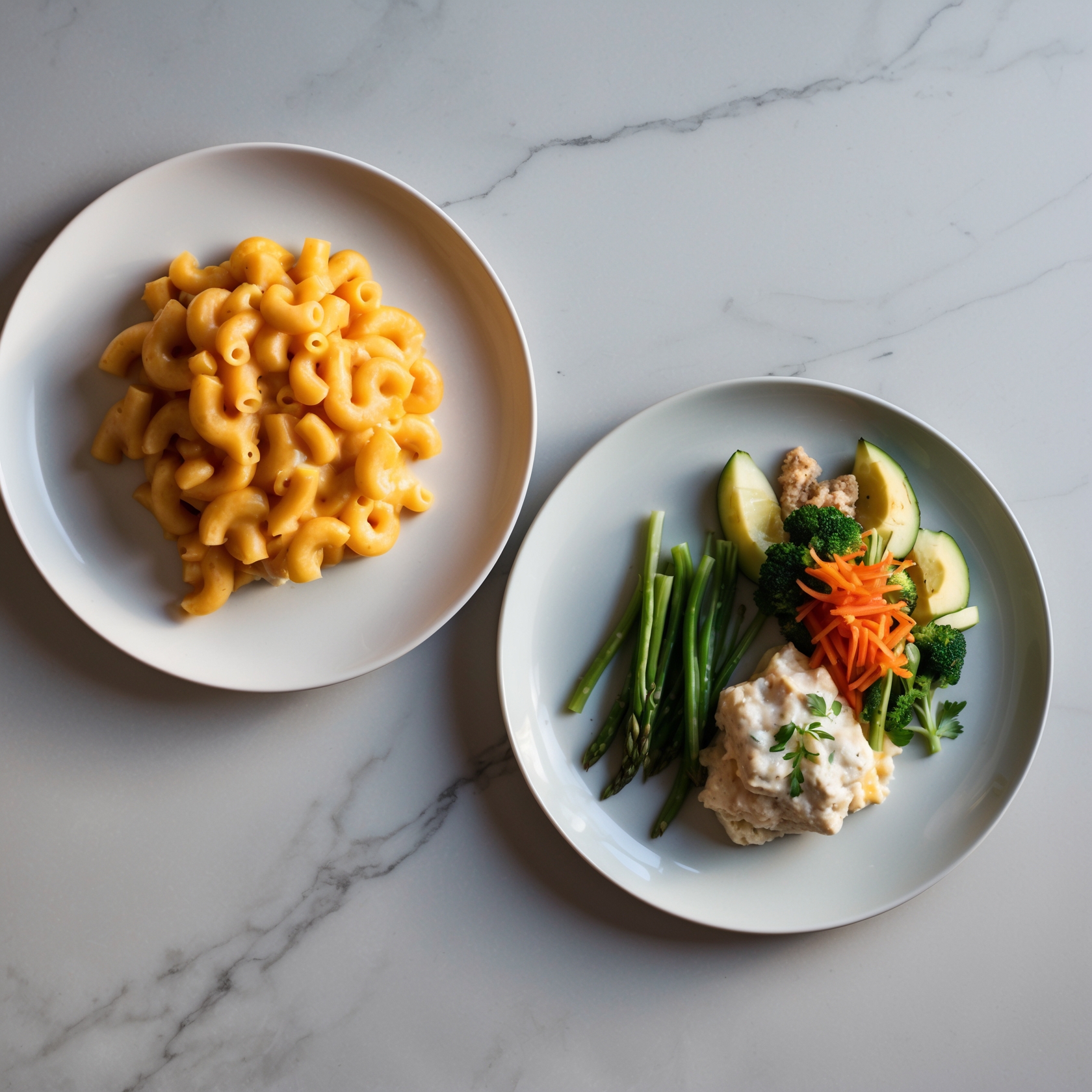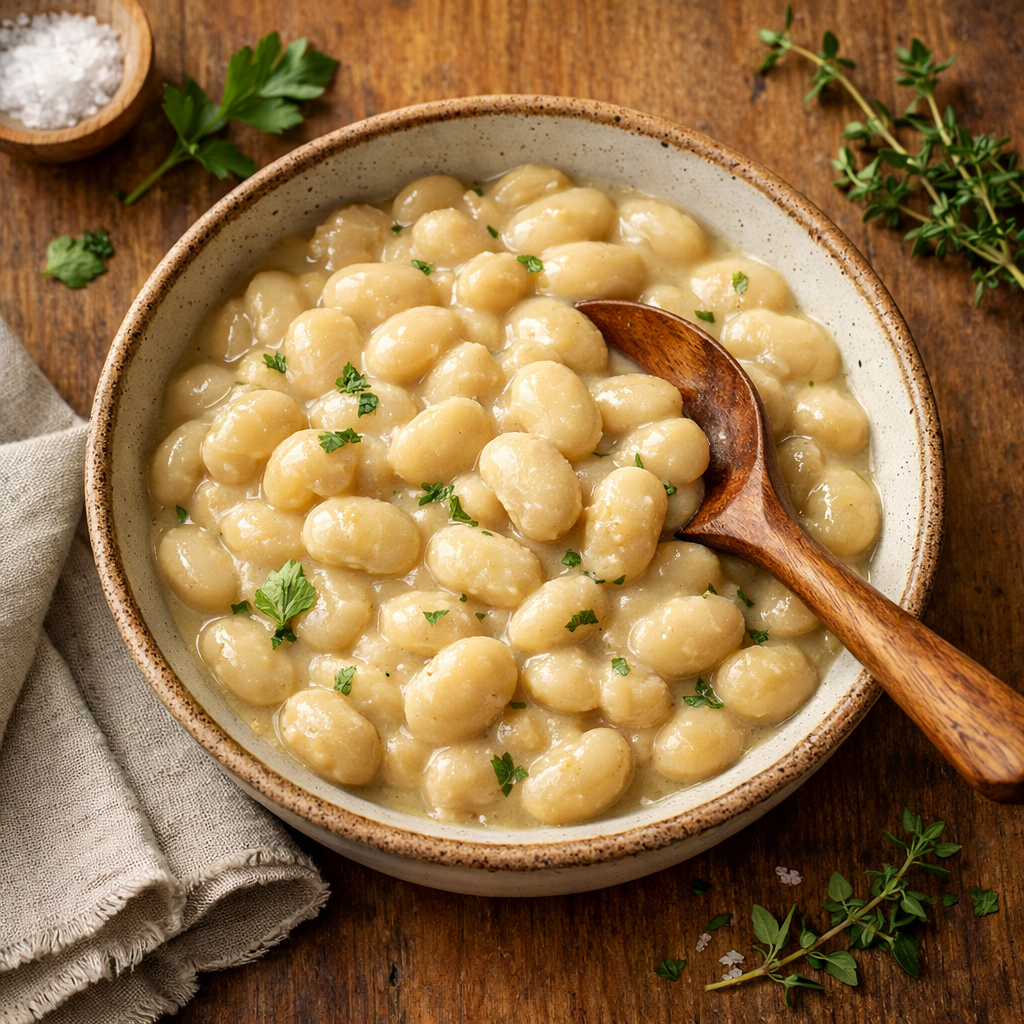Growing up, I was that kid who wouldn’t let different foods touch on my plate. My mom would spend hours trying to convince me to try new vegetables, but I stood firm in my comfort food favorites – plain pasta and grilled cheese sandwiches. Now, as an adult and parent of a selective eater, I’ve come full circle—not only working through my own relationship with comfort food but also connecting with other parents raising selective eaters and understanding their journey.
One day, scrolling through social media, I stumbled upon a group of parents who got it—really got it. That’s where I met Beth. Like me, she was trying to figure out meals for her 20-year-old son, who had very specific food preferences. We clicked right away, trading stories about dinner table wins and struggles. Now, we message each other almost daily, sharing little victories and “you won’t believe what happened” moments. Just last week, she messaged me excitedly about her son trying a new vegetable dish she prepared. When she asked me for advice, I emphasized the importance of patience—something I’ve learned through my own journey.
These connections have shown me that selective eating isn’t something we simply outgrow. It’s a complex relationship with food that deserves understanding and respect, regardless of if we’re dealing with it personally or supporting loved ones through their journey.
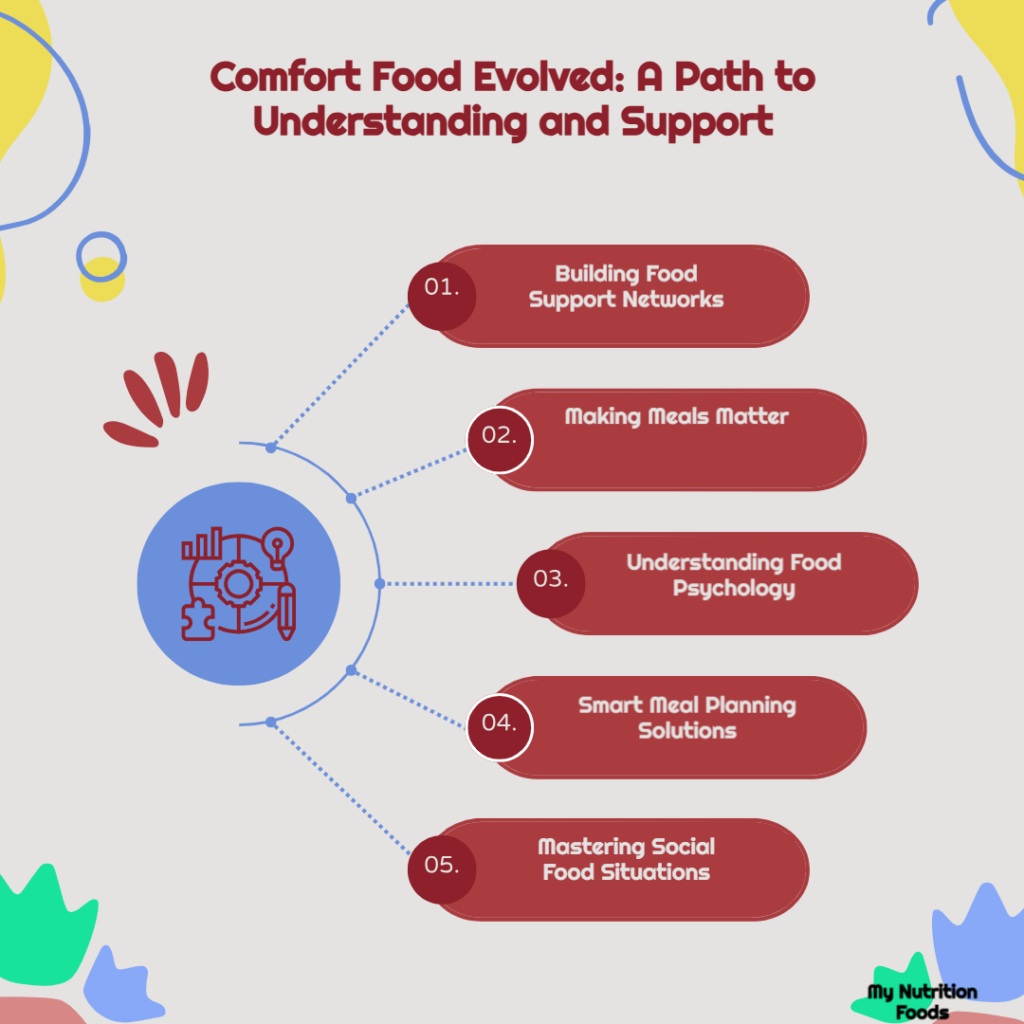
Shared Experiences and Community Support
My conversations with other parents and adults who identify as selective eaters have taught me valuable lessons about patience and understanding. Beth’s journey with her son mirrors many others’ experiences. She shared how frustrated she felt when traditional advice like “they’ll eat when they’re hungry” didn’t work for her adult son. Through our discussions, she discovered that small changes and open communication made more impact than pressure or ultimatums.
Many parents in our online community have found success by:
- Making Meals Feel Like Home
You know what made the biggest difference for me? Turning mealtimes into cozy, no-pressure zones. One mom in our group shared how she stopped asking, “Just try one bite,” and instead started telling funny stories during dinner. Before she knew it, her family was laughing together, and food wasn’t this big, scary thing any more—it was just part of hanging out together.
- Celebrating Small Wins
Every little step counts. When Beth’s son willingly tried a new preparation of chicken, it was a breakthrough moment worth celebrating. These victories, no matter how small, build confidence for future food exploration.
- Learning from Each Other
Our community shares modified recipes that have worked, strategies for introducing new foods, and, most importantly, emotional support. We understand that what works for one person might not work for another, and that’s perfectly okay.
- Building Trust
Many parents notice that when they stop pushing and start listening, their adult children become more open to trying new foods on their own terms. One dad shared how his daughter started asking questions about his cooking once he stopped suggesting she “just try a bite.”
Living with Texture Sensitivities
For as long as I can remember, texture has always been my biggest challenge. Mushy vegetables? That’s still a hard pass for me. But over time, I’ve learned that this sensitivity isn’t a flaw – it’s just part of who I am. Some of us experience food differently, whether it’s through heightened sensitivity to textures, strong reactions to certain flavors, or comfort in familiar routines. Like many in our online community, I’ve found that acknowledging these sensitivities is the first step toward self-acceptance.
What I’ve come to understand about myself and other selective eaters is that our food preferences often have deep roots. Maybe it’s the mac and cheese your grandmother made when you were sick, or the peanut butter and jelly sandwiches that got you through college. These aren’t just meals – they’re memories, comfort, and security wrapped in familiar flavors. Beth and other parents in our group often share similar stories about their children’s comfort foods, reminding us that these connections to food are both personal and universal.
Understanding the Psychology of Food Preferences
Through my journey with selective eating and connecting with others in similar situations, I’ve discovered that our food choices run deeper than simple likes and dislikes. Living with selective eating brings up complex emotions that many don’t understand.
I still remember the knot in my stomach before social gatherings, wondering what food would be served and if I’d have to explain my preferences yet again. These experiences taught me valuable lessons about the emotional aspects of eating:
Fear and Anxiety
For many of us, trying new foods triggers genuine anxiety. It’s not stubbornness – it’s a real emotional response that deserves understanding and patience.
Control and Comfort
Our food preferences often tie into our need for control and predictability. When life gets stressful, we reach for familiar foods that help us feel grounded and safe.
Social Pressure
Being a selective eater can feel isolating, especially when well-meaning friends and family try to convince us to “just try” something new. I’ve learned that acceptance and understanding work better than pressure.
Past Experiences
Our food memories shape our current choices. One bad experience can create lasting impressions – like my years-long aversion to seafood after getting sick once. Recovery takes time and patience.
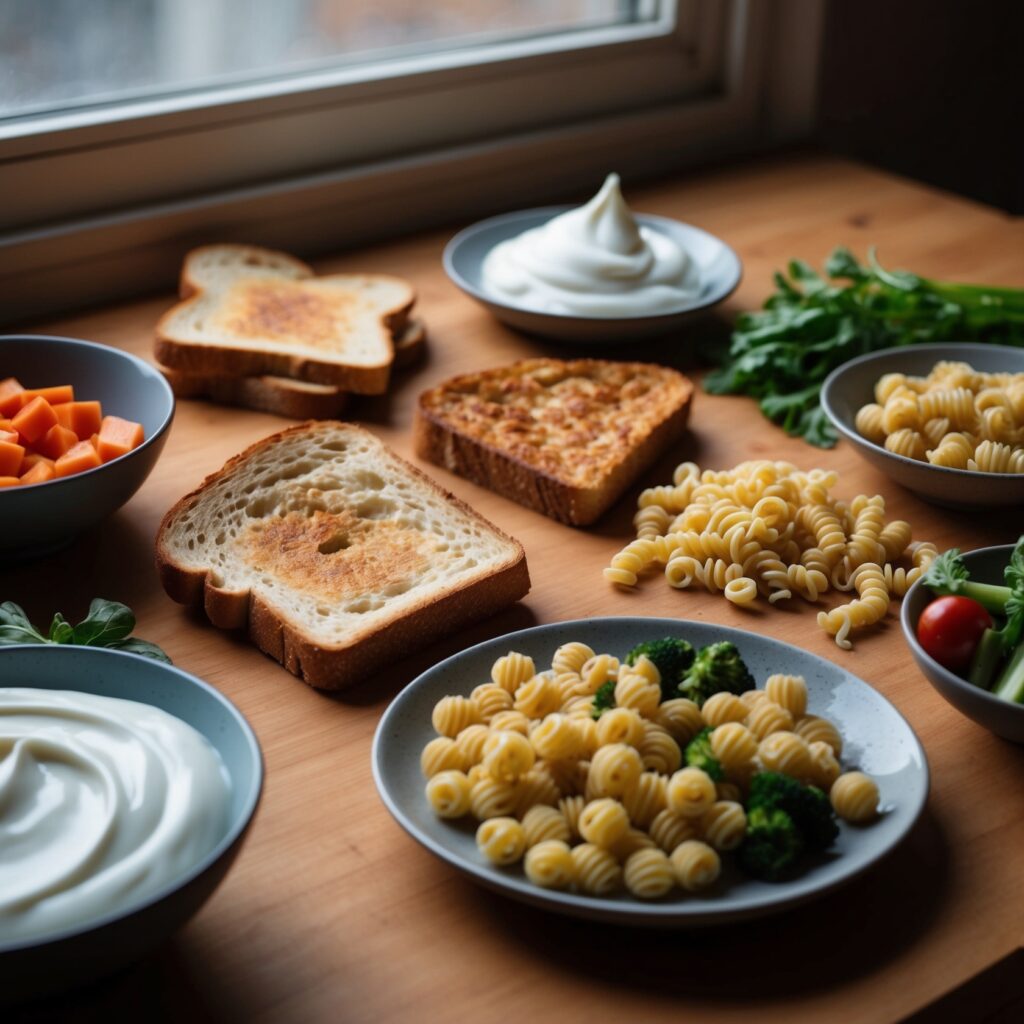
Breaking the Cycle and Embracing a Growth Mindset
Understanding these psychological aspects has helped me develop a better approach to both my own eating habits and James’. We talk openly about our food feelings, acknowledge progress (like when James tried sweet potato fries!), and never shame ourselves or each other for our preferences.
One of the most powerful shifts in my thinking came when I stopped seeing selective eating as something to “fix” and started viewing it as a unique part of who we are – something we can work with rather than against. I share this mindset with James, helping him understand that it’s okay to have preferences while staying open to new possibilities.
Practical Meal Planning Strategies That Work
Through years of trial and error, I’ve developed meal planning strategies that make life easier for selective eaters. Here’s what I’ve found most effective:
The Two-Option Approach
I always plan at least two options for main dishes – one familiar and one new. This takes the pressure off trying new foods while maintaining a safety net. For example, when introducing quinoa, I’ll also prepare rice as a backup. This way, there’s always something comfortable to fall back on if the new food doesn’t work out.
Prep-Ahead Method
Sunday meal prep has become my secret weapon. I spend 2–3 hours preparing:
- Basic protein options (grilled chicken, baked tofu)
- Roasted vegetables in different textures
- Cooked grains (rice, pasta, quinoa)
- Pre-portioned snacks
- Simple sauces and dressings
This variety allows for quick meal assembly throughout the week while accommodating different preferences and comfort levels.
Sunday meal prep becomes a breeze with the right tools. The Breville Sous Chef 12-Cup Food Processor simplifies chopping, slicing, and pureeing, saving you time and ensuring your ingredients are perfectly prepped for quick meal assembly throughout the week.
- Grating cheese and chopping herbs or nuts to mixing batters and pureeing soups
- 12 cup cap; BPA Free plastic work bowl; Safety braking system
- Large 5" wide feed chute eliminates need to precut most ingredients
- Momentary pulse button for maximum control and even processing
- 1000 watt induction motor offers great versatility and power in a compact size
The Building Block System
I organize meals into interchangeable components:
- Base (grains or starches)
- Protein
- Vegetables
- Sauces/seasonings
Each component can be mixed and matched, allowing for customization while maintaining nutritional balance. I might prepare one base protein but serve it in different ways – sliced on salads, wrapped in tortillas, or paired with pasta.
Strategic Leftovers
I plan meals so leftovers can transform into new dishes. Monday’s grilled chicken becomes Tuesday’s chicken salad or Wednesday’s pasta topping. This approach saves time while providing variety within comfort zones.
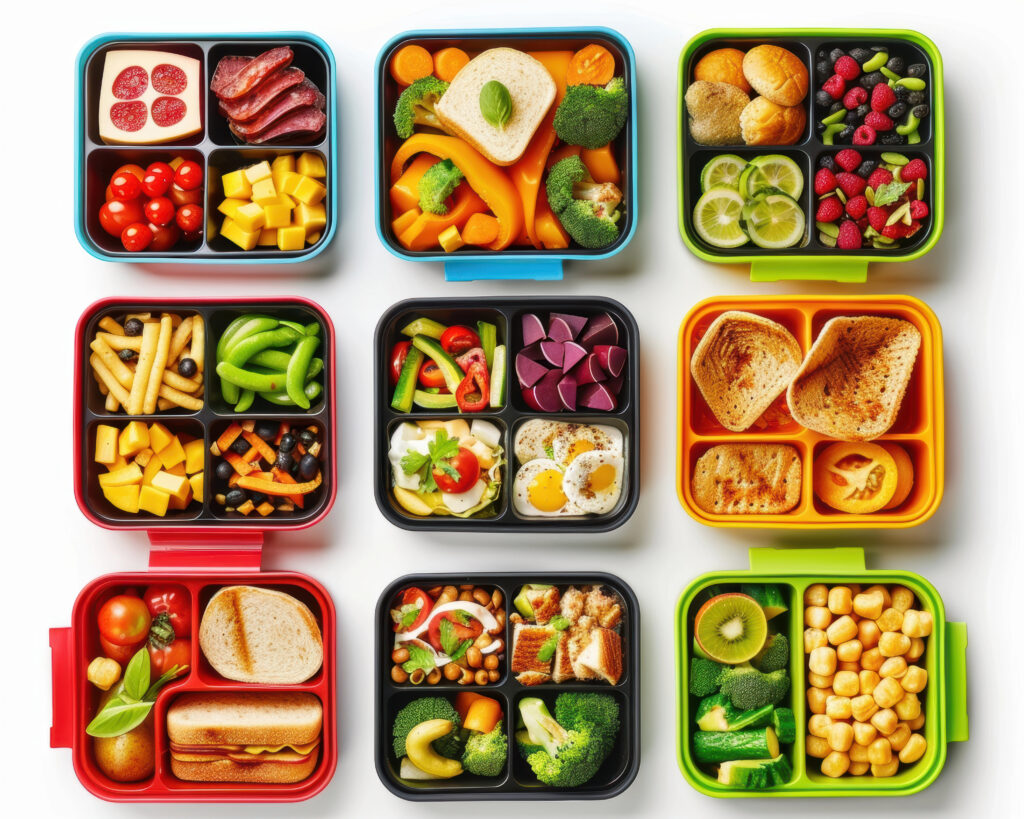
Navigating Social Situations and Dining Out
Social eating can be challenging for selective eaters, but I’ve developed strategies to make it more manageable:
My Restaurant Detective Work
Want to know my secret for eating out without stress? I turned into a menu detective! Before trying anywhere new, I hop online and scope things out. I’m looking for my safety nets – you know, those dishes I can tweak if needed, simple stuff that won’t have any surprise ingredients, and places that won’t give me the side-eye when I ask for my sauce on the side.
This preparation helps reduce anxiety and ensures I’ll find something comfortable to eat.
Buffet Strategies
At buffets or potlucks, I:
- Take a preliminary walk around to survey all options
- Start with familiar foods
- Sample new items in very small portions
- Keep portions separate on the plate
Communication Skills
I’ve learned to communicate my preferences clearly but politely:
- “I have some texture sensitivities”
- “Could you please serve the sauce on the side?”
- “I prefer my vegetables crisp-tender
Social Gathering Tips
For parties or dinner invitations:
- I offer to bring a dish I know I can eat
- I eat a small meal beforehand if I’m uncertain about the menu
- I focus on the social aspect rather than the food
- I keep energy bars in my bag for backup
Business Meals
Professional dining situations require extra planning:
- I research the venue in advance
- I arrive early to speak privately with the server about modifications
- I choose simple menu items that are easy to eat while talking
- I focus on networking rather than the meal itself
These strategies help maintain social connections without compromising comfort levels around food. They’ve allowed me to participate fully in social events while honoring my food preferences.
Comfort Food Makeovers: My Favorite Recipes
Let me share some recipes that have won over even the most selective eaters in our community. These are tried-and-true favorites that maintain familiar flavors while sneaking in extra nutrition.
Breakfast Wins
Upgraded Pancakes
My go-to weekend breakfast brings comfort and nutrition together:
- 1 cup whole grain flour
- 1 cup Greek yogurt
- 2 eggs
- 1 mashed ripe banana
- 1 teaspoon vanilla extract
- 1 teaspoon baking powder
- Pinch of salt
- Maple syrup for serving
Mix wet and dry ingredients separately, then combine. Cook on a medium-hot griddle until golden brown.
Smooth and Creamy Overnight Oats
A breakfast that feels like dessert:
- ½ cup old-fashioned oats
- ½ cup milk of choice
- ¼ cup Greek yogurt
- 1 tablespoon maple syrup
- 1 tablespoon nut butter
- Dash of vanilla
- Pinch of salt
Mix all ingredients in a jar, refrigerate overnight. Top with sliced bananas and a drizzle of honey.
Lunch Champions
Grown-Up Grilled Cheese
A sophisticated take on the classic:
- Sourdough bread
- Sharp cheddar
- Gouda or mild cheese
- Thin apple slices (optional)
- Butter for grilling
Build your sandwich with both kinds of cheese, add apple if using. Butter outside of bread, grill until golden and melty.
Pasta Salad Your Way
A customizable lunch option: Base:
- 1 pound pasta shapes
- 2 tablespoons olive oil
- Salt and pepper to taste
Mix-and-Match Additions (choose what works for you):
- Diced cucumber
- Cherry tomatoes
- Diced bell peppers
- Shredded carrots
- Cubed cheese
- Diced ham or turkey
- Italian dressing

Dinner Solutions
Better-Than-Takeout Rice Bowl
Start with:
- 2 cups cooked rice
- Protein of choice (grilled chicken, tofu, or shrimp)
Customizable toppings:
- Steamed broccoli
- Shredded carrots
- Corn kernels
- Edamame
- Sweet and sour sauce
Presentation matters, especially for selective eaters. The Le Creuset Enameled Cast Iron Braiser not only cooks food evenly but also enhances your table with its vibrant, inviting design. Use it to prepare flavorful one-pot meals that look as good as they taste.
- Enameled cast iron delivers superior heat distribution and retention
- Ready to use, requires no seasoning
- Easy-to-clean and durable enamel resists dulling, staining, chipping and cracking
- Light colored smooth interior enamel allows easy monitoring of cooking progress
- Tight-fitting lids are specially designed to circulate steam and return moisture back to the food
Crispy Baked Chicken Tenders
A healthier version of the classic:
- 1 pound organic, free-range chicken tenders
- 1 cup almond flour (or finely crushed whole-grain crackers for a gluten-free option)
- ¼ cup nutritional yeast (a great substitute for parmesan, packed with B vitamins)
- 1 teaspoon garlic powder (organic if possible)
- 1 egg (pasture-raised) beaten with 1 tablespoon unsweetened almond milk
- ¼ teaspoon smoked paprika (optional, for added flavor)
- Pinch of Himalayan pink salt or sea salt and
- freshly ground black pepper to taste
Instructions:
- Preheat the oven to 400°F (200°C) and line a baking sheet.
- Mix almond flour, nutritional yeast, garlic powder, paprika, salt, and pepper in a bowl.
- Whisk egg and almond milk in another bowl.
- Dip chicken tenders in the egg, then coat with the almond flour mixture.
- Place on the baking sheet and bake for 15-20 minutes, flipping halfway, until golden and cooked through (165°F internal temperature).
- Serve with fresh veggies or a healthy dip.
Snack Solutions
Sweet and Salty Popcorn Mix
- 6 cups air-popped popcorn
- 2 tablespoons melted butter
- 1 tablespoon maple syrup
- ¼ teaspoon cinnamon
- Pinch of salt
Toss all ingredients together while popcorn is warm.
Base:
- Plain or vanilla yogurt
Toppings (choose your favorites):
- Granola
- Fresh berries
- Sliced almonds
- Honey
- Mini chocolate chips
Dessert Innovations
No-Bake Energy Balls
- 1 cup old-fashioned oats
- ½ cup nut butter
- ⅓ cup honey
- ¼ cup mini chocolate chips
- 1 teaspoon vanilla extract
Mix all ingredients, roll into balls, refrigerate until firm.
Fruit and Yogurt Pops
- 2 cups Greek yogurt
- 2 cups mixed berries
- 2 tablespoons honey
- 1 teaspoon vanilla extract
Blend ingredients, pour into popsicle molds, freeze until solid.

Sauce and Dip Library
Universal Dipping Sauce
- ½ cup Greek yogurt
- 2 tablespoons mayonnaise
- 1 teaspoon honey
- 1 teaspoon lemon juice
- Salt and pepper to taste
Mix all ingredients until smooth. Perfect for vegetables, chicken tenders, or as a sandwich spread.
For silky-smooth sauces and nutrient-packed smoothies, the Vitamix A3500 is the ultimate kitchen powerhouse. Its precision blending capabilities make it easy to incorporate new ingredients into meals while achieving the perfect texture for even the pickiest eaters.
- Program Settings: Five program settings ensure walk-away convenience and consistent results
- Container Capacity: 48-Ounce Container is ideal for small to medium-sized blends
- You're in Control: Variable Speed Control and Pulse feature let you manually fine-tune the texture of any recipe
- Built-In Wireless Connectivity: The motor base can detect the container size and automatically adjust program settings and maximum blending times accordingly. Add a range of compatible containers and attachments, building a customized system designed to fit your needs
- Touch Interface: Touchscreen controls give the machine a sleek silhouette and are easily wiped clean
Smooth Tomato Sauce
- 1 can crushed tomatoes
- 2 tablespoons olive oil
- 2 cloves garlic, minced
- 1 teaspoon Italian herbs
- Salt and pepper to taste
Sauté garlic in olive oil, add remaining ingredients, simmer for 20 minutes. Blend if a completely smooth texture is preferred.
Parting Thoughts
Looking back at my journey – from being that kid who freaked out when foods touched on the plate to where I am now – I’ve discovered that growth doesn’t mean abandoning comfort foods. For all parents with selective adult children like myself, I understand that change happens gradually. Through thoughtful meal planning and patience, I’ve learned that creating an environment of acceptance while maintaining nutritional balance is key to progress.
The path of selective eating isn’t about giving up the foods that make us feel safe – it’s about finding creative ways to blend comfort with nutrition. Through strategic meal planning, we can build bridges between familiar favorites and new possibilities. From preparing multiple dinner options to gradually introducing new ingredients alongside trusted ones, remember that nourishment looks different for everyone.
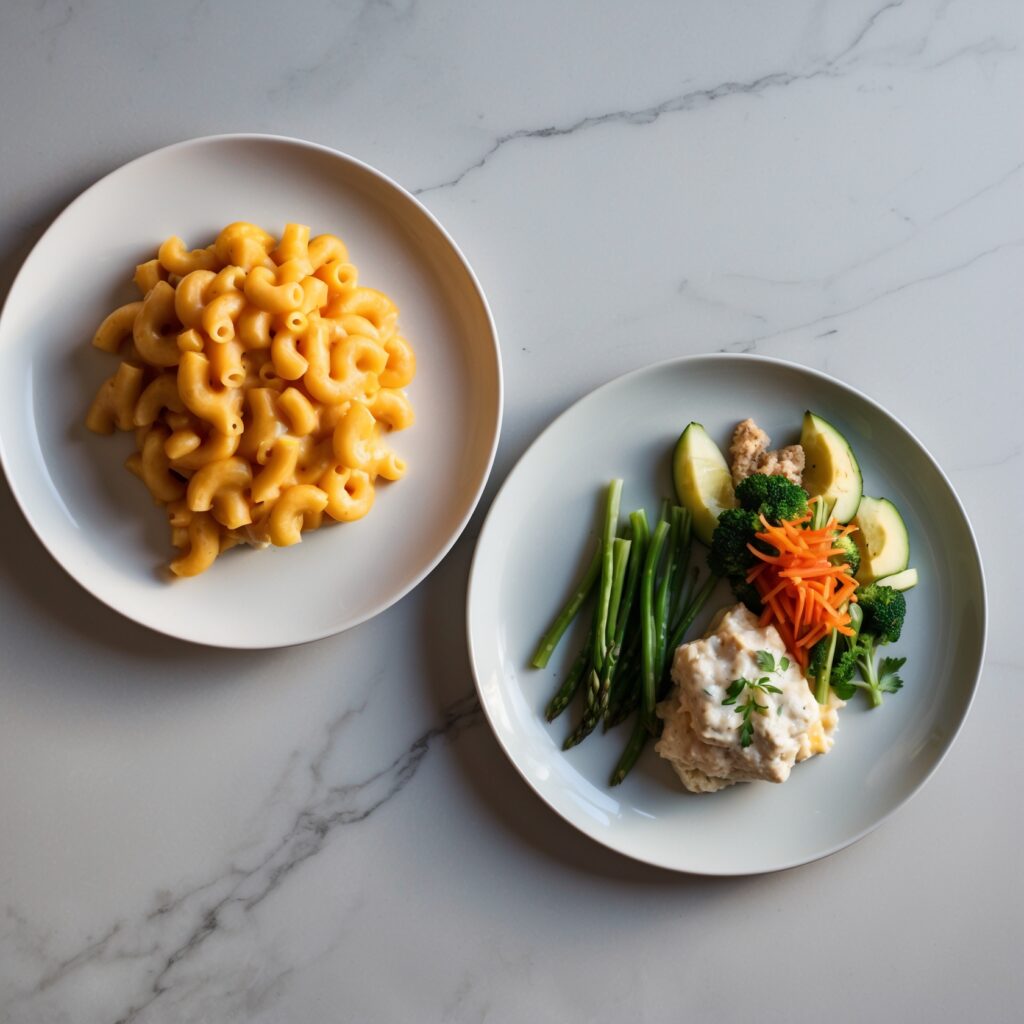
*We may earn a commission for purchases made using our links. Please see our disclosure to learn more.

